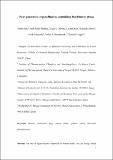Next generation organofluorine containing blockbuster drugs
Abstract
The role of organo-fluorine compounds in modern health, food and energy related industries is widely-appreciated. The unique properties that fluorine imparts to organic molecules, stemming from its high electronegativity and stability when bound to carbon, finds it increasing being used in the development of new bioactivities. Around 25% of the current blockbuster drugs contain fluorine and this number is increasing to well above 30% for recent FDA approvals. In this Review we highlight a selection of the most successful organo-fluorine drugs, that have achieved blockbuster status, namely, sitagliptin (diabetes), sofosbuvir (hepatitis C), emtricitabine (HIV), glecaprevir/pibrentasvir (hepatitis C), elvitegravir (HIV), dolutegravir (HIV), bictegravir (HIV), efavirenz (HIV), enzalutamide (prostate cancer), aubagio (immunomodulatory) and paliperidone palmitate (schizophrenia). For each compound we discuss their discovery, their relevant disease state and how they are made, emphasizing the source of fluorine-containing moieties, and where known, their mode of action.
Citation
Han , J , Remete , A M , Dobson , L S , Kiss , L , Izawa , K , Moriwaki , H , Soloshonok , V A & O’Hagan , D 2020 , ' Next generation organofluorine containing blockbuster drugs ' , Journal of Fluorine Chemistry , vol. 239 , 109639 . https://doi.org/10.1016/j.jfluchem.2020.109639
Publication
Journal of Fluorine Chemistry
Status
Peer reviewed
ISSN
0022-1139Type
Journal item
Description
Funding: the National Natural Science Foundation of China (No. 21761132021), the Hungarian Research Foundation (NKFIH No. K 119282), and Ministry of Human Capacities, Hungary grant 20391-3/2018/FEKUSTRAT. The Qinlan Project of Jiangsu Province, and IKERBASQUE, the Basque Foundation for Science are also acknowledged.Collections
Items in the St Andrews Research Repository are protected by copyright, with all rights reserved, unless otherwise indicated.

